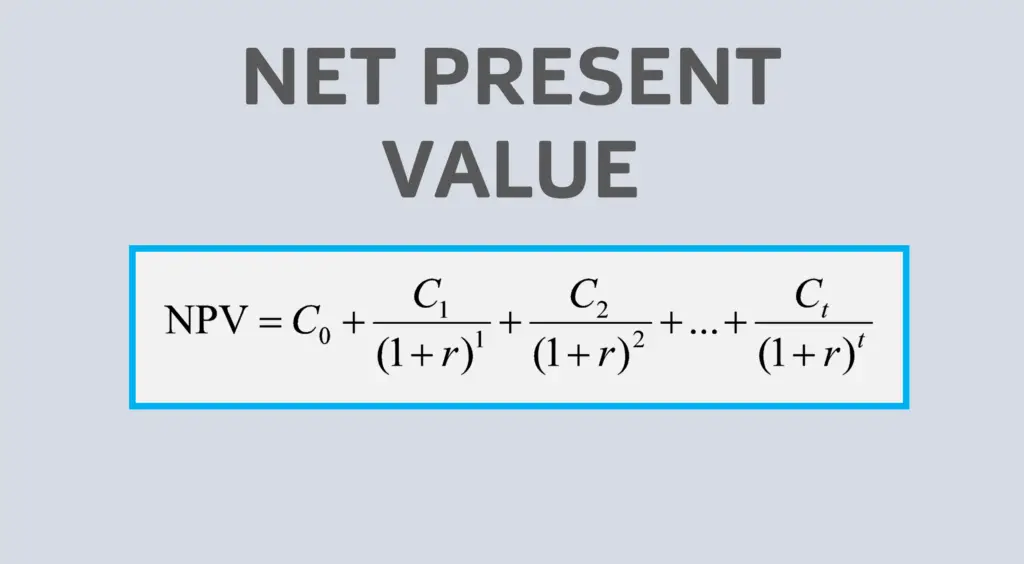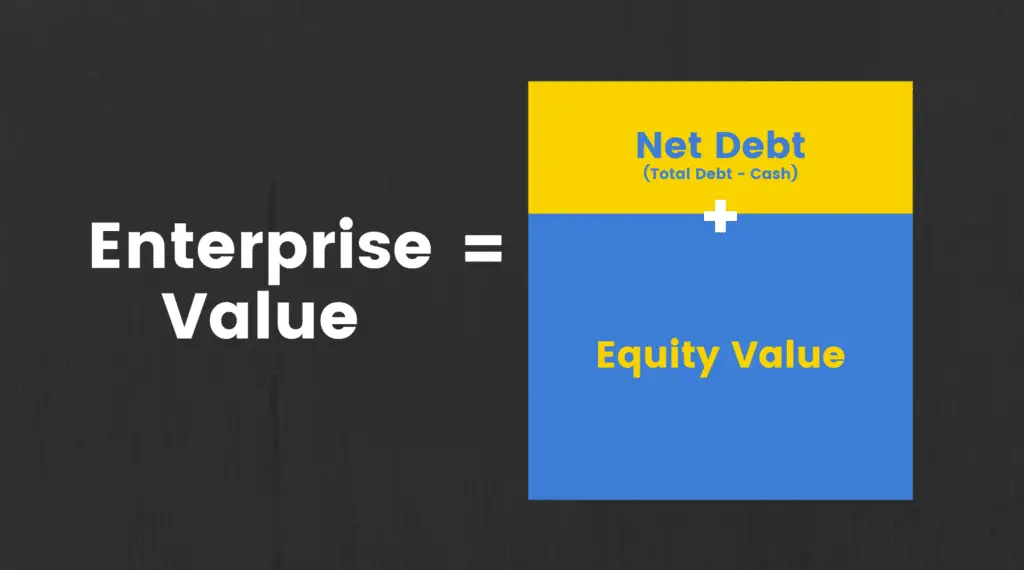This post may contain affiliate links, which means I’ll receive a commission if you purchase through my links, at no extra cost to you. Please read full disclosure for more information.
The management teams of businesses keep their eyes open to opportunities to invest and expand to increase the value of the firm.
During the capital budgeting process, a company will analyze potential investments in a variety of ways.
One method of analyzing the profitability of an investment is through the use of the net present value.
WHAT IS NET PRESENT VALUE?
Net present value (NPV) is the present value of all future cash flows of a project or investment in excess of the initial amount invested. The future cash flows are discounted at the company’s cost of capital, adjusted for specific risk to the investment.
Companies use this metric when planning for capital budgeting and investment.
It is commonly used because it takes into account cash inflows, cash outflows, and the time value of money.
The goal of any company is to increase shareholder wealth. A positive net present value indicates that the investment will exceed the costs of the initial investment and cost of capital. This leads to an increase in shareholder wealth.
A negative NPV value would result in a decrease in shareholder wealth because the investment would not cover the costs of initial investment and the cost of capital.
NET PRESENT VALUE FORMULA
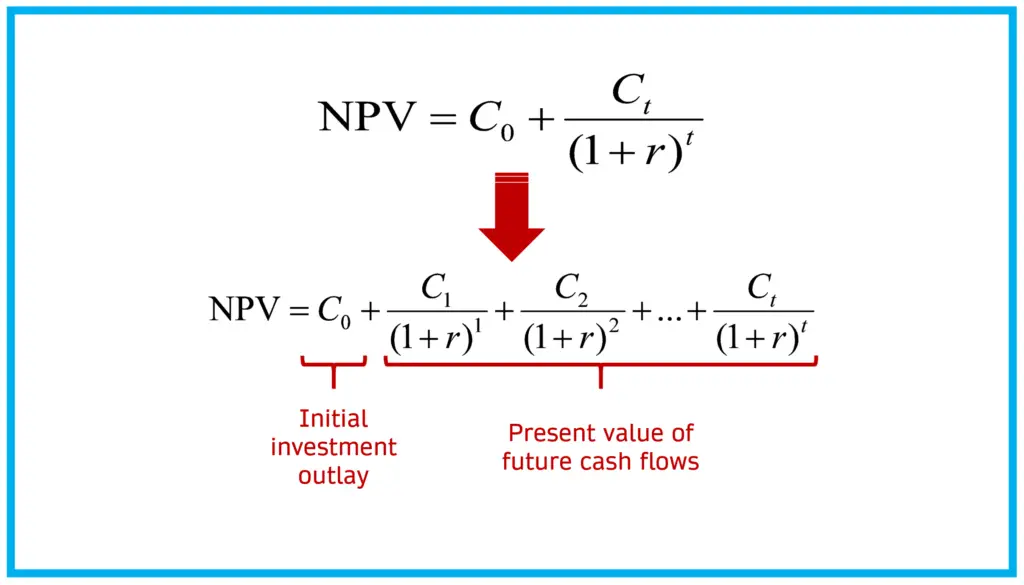
- C0 = Initial cash flow (often negative)
- C1 = Cash flow at time 1
- C2 = Cash flow at time 2
- Ct = Cash flow at time t
- t = Time period of the investment
- r = Opportunity cost of capital
The NPV formula shows the present value of all cash flow streams over periods of time (usually years). The first part of the equation shows C0, which is the initial investment in the project/asset.
An investment is an outflow of cash so this value is negative and is added to the sum of the present values. Note that adding a negative number is the same as simply subtracting the number.
The rest of the NPV formula is used to calculate the present value of each year for t. If t=3, there will be a present value calculation of a cash flow at year 1, year 2, and year 3.
See these related posts next:
Example NPV Calculation
A project costs $100 and will have a cash flow in year 1 of $30, a cash flow of $50 in year 2, and a cash flow of $70 in year 3.
Compute the NPV of the project assuming the cost of capital is 8%.
Variables
- C0 = -$100
- C1 = $30
- C2 = $50
- Ct = $70
- t = 3
- r = 8%
Equation
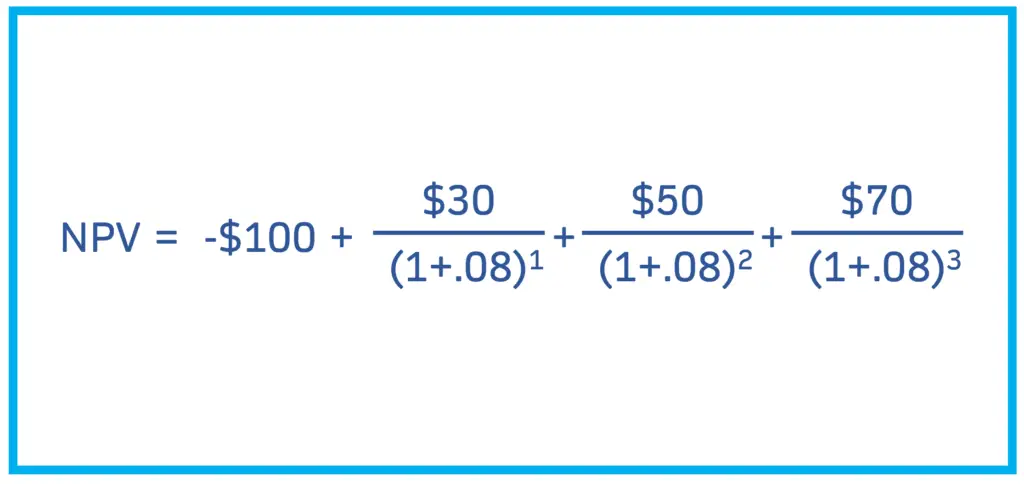

THE NPV RULE

The Net Present Value Rule or NPV Rule is a simple rule that helps companies and investors decide whether they should take on an investment or not.
The NPV Rule states that investing in something that has an NPV greater than zero increases shareholder wealth and should be pursued.
An investment with an NPV less than zero will decrease shareholder wealth and should not be pursued.
A negative NPV doesn’t necessarily imply the investment will lose money. It could be profitable, but a negative NPV means the return won’t exceed the company’s cost of capital, therefore decreasing shareholder value.
If the investment does not exceed a company’s cost of capital, the money is better off invested in something else.
An investment with an NPV of zero is neutral to the company, with no effect on earnings for shareholder value. A project is neither good nor bad with an NPV of zero. However, pursuing a project with an NPV of zero can be good if the project/investment undertaken results in positive goodwill.
An example of this would be replacing all lighting in a hotel with LED lights to become more “green-conscious” in the eyes of the community.
When using NPV to compare multiple investments, the investment with the largest NPV will provide the highest return and will be the most beneficial to the company.
ADVANTAGES OF NET PRESENT VALUE
NPV is commonly used to determine the profitability of potential projects because of how comprehensive it is.
Unlike other metrics, NPV takes into account the time value of money. It uses the company’s discount rate, adjusted for risk, and looks at the cash inflows and outflows of a potential investment.
The result of the NPV formula gives managers a very black and white result. If the value is positive, pursue the project. If it is negative, don’t pursue the project.
DISADVANTAGES OF NET PRESENT VALUE
Assumptions and Estimates
The biggest disadvantages of the net present value calculation revolve around the assumptions and estimates made for the variables in the formula.
These include:
- Estimations for total investment costs
- Discount rate
- Adjustments to discount rate based on unique project risk
- Expected cash flow amounts
Any of these variables are susceptible to incorrect assumptions or estimates. They can also easily be manipulated to achieve a desired result.
The NPV should not be used alone in investment analysis. There are other metrics including the internal rate of return (IRR), cash on cash return, and payback period that should be considered alongside NPV.
Project Size
NPV does not take the size of the project into consideration. For example, an NPV of $1,000 is great when the initial investment is $2,000, but would be negligible if the initial investment was $1,000,000.
Impact on other areas of business
Another disadvantage of NPV is that it only looks at the profitability of a single project or investment. It does not indicate how the investment will affect other parts of the business.
Will the investment complement the business and add to revenues or will the investment cannibalize certain revenue streams?
This is a question that a company needs to ask and have an answer for.
3 WAYS TO CALCULATE NET PRESENT VALUE
Let’s go through an example together, calculating NPV in 3 different ways.
Each method will arrive at the same answer but you may find that you’ll prefer one method over another.
Someone has presented you with the opportunity to purchase a popular office building for $400,000. The office building is expected to generate $40,000 per year in cash flows for 3 years. At the end of the 3 years, you anticipate that you can sell the office building for $500,000.
What is the NPV assuming a 7% cost of capital?
Using the formula
To calculate NPV using the formula, you will calculate the present value of the cash flow from year 1, 2, and 3. You will discount them using the given cost of capital of 7%.
Note how year 3 has a cash flow of $540,000. This is due to the sale of the office building in year 3. This means that year 3 has a cash flow of $40,00 like year 1 and 2, but it also has a cash flow of $500,000 from the entire sale.
After that, sum up the initial investment outlay and the present values for year 1, 2 and 3.
You’ll arrive at a net present value of $113,122.
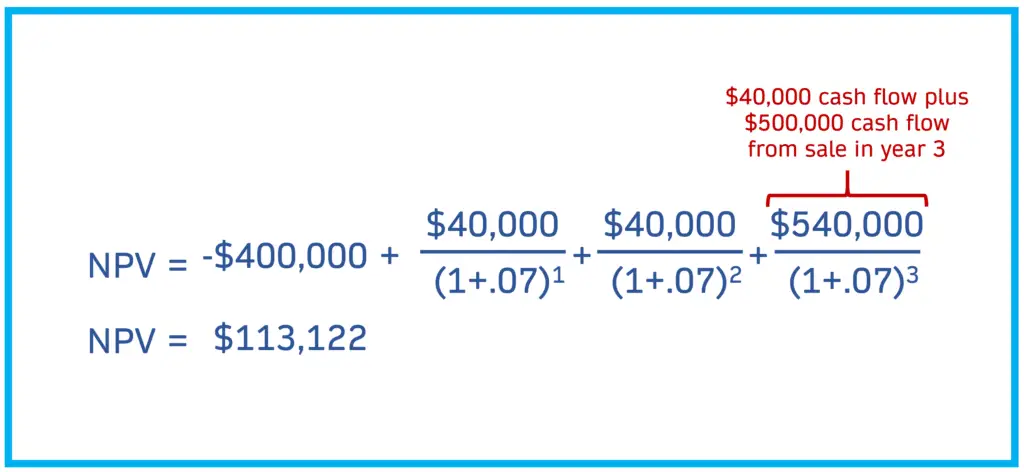
Using Excel
Excel has a built-in function for net present value.
To begin, organize your cash flows into a table, beginning with the cash flow at t=0 going through to t=3. Remember that the cash flow at t=0 is an investment and is a negative outflow.
Have your discount rate in a cell of its own.

Create the function by typing in “=NPV” and fill in the arguments.
- rate = 7%
- value1 = cash flow 1 = $40,000
- value2 = cash flow 2 = $40,000
- value3 = cash flow 3 = $540,000
Close the NPV function with a parenthesis and then add the initial investment amount from cell C5. Adding a negative value is essentially subtracting the value.
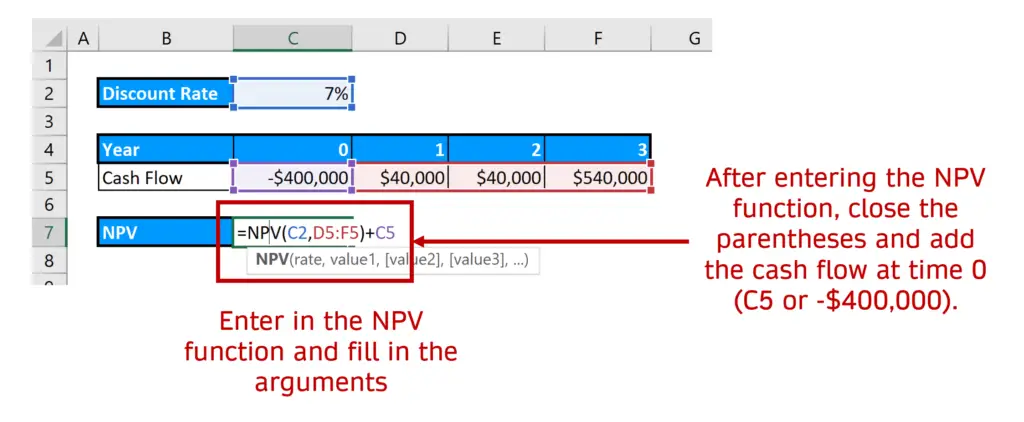
When you hit enter, the function will return the NPV value of $113,122, the same value we calculated previously using the formula.
Using Excel to calculate NPV is beneficial because of the speed you can calculate it.
Organizing your cash flows into a table allows for you to easily see what is going on as well.
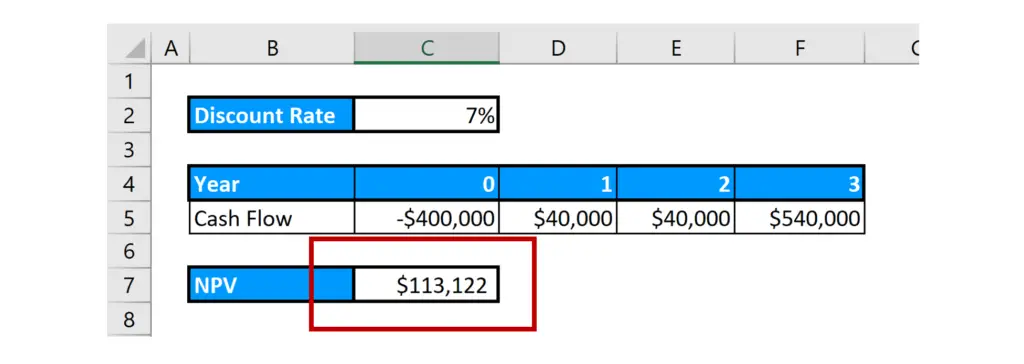
Using a Financial Calculator
The third way to calculate net present value is with a financial calculator.
In my professional life, I have rarely used a financial calculator because Excel is more convenient for the work I do.
Financial calculators are used frequently in college classes and when studying for the CFA.
As you can see in the picture, I literally had to wipe the dust off of this TI Business Analyst II Plus.
To find the NPV of our example using a financial calculator, follow the keystrokes in the table below.

Once again, we arrive at the NPV of $113,122.
There are 3 ways you can calculate NPV. Try them out and use what works best for you!
SUMMARY
Net present value is a commonly used calculation in capital budgeting.
It is comprehensive by taking into account the time value of money, the costs of initial investment, and the positive cash inflows.
This also leads to the main drawback of using NPV. The variables in the NPV formula need to have precise assumptions and estimates or the accuracy of the calculation will be off.
If a company is confident in its inputs, then using the net present value can be an effective way of determining which investments and projects a company should pursue.
In addition to NPV, use other metrics and financial ratios to analyze an investment. Examples include the internal rate of return (IRR), cash on cash return, and payback period.

